Was Einstein totally against Quantum Mechanics?
Einstein was one of the creators of quantum mechanics. His work on the photo-electric effect played the pivotal role in establishing the wave-particle duality. Indeed, he was awarded the 1921 Nobel Prize in physics for this work, not for his theory of relativity.This means that Einstein could not afford to be totally against quantum mechanics. However, it is possible that he was against at least one aspect of quantum mechanics. Which aspect did he dislike?
- In his theory of special relativity, the simultaneity is a relative
concept. If two events happen simultaneously at two different places,
they do not appear simultaneous to a moving observer.
On the other hand, the concept of simultaneous measurements is the core of the Copenhagen interpretation of the uncrternty principle. For instance, in the EPR set up, the measurements take place at two different places.
- In 1953 and 1954, two important physicists visited Einstein.
- In 1953, Hideki Yukawa visited Einstein at the
Institute for Advanced Study
in Princeton. They had
this photo. They appear to be very happy.
Then, what did Yukawa tell Einstein? I do not know since I was not there, but it is not difficult to guess what happened from Yukawa's 1953 paper published in the Physical Review. Yukawa must have talked about what he wrote in this paper.
- In 1954, Werner Heisenberg visite
Einstein's house in Princeton to ask Einstein to accept his
uncertainty principle as a fundamental law of physics,
but he failed to change Einstein's mind.
Click here for a detailed story.
- Einstein's photo with Yukawa appeared in June of 1953. It is possible that Heisenberg decided to visit Einstein after seeing this photo.

This image of Einstein and Yukawa is from Maininchi Shinbun (1981.9.9). The image of Heisenberg from AIP E. Segre Visual Archives. 
- In 1953, Hideki Yukawa visited Einstein at the
Institute for Advanced Study
in Princeton. They had
this photo. They appear to be very happy.
- The question then is why Einstein was so unhappy with Heisenberg,
while he was happy with Yukawa. The answer is very simple.
Heisenberg was talking to him about the topic Einstein was not
interested in, while Yukawa was telling a story Einstein wanted to
hear.
- Heisenberg in his article says
he could handle the mathematics of Lorentz transformations, but he
could not understand the physics of simultaneity. With this kind
of background, nobody could talk to Einstein. As for the
simultaneity, look at this page.
- According to
his 1953 paper, Yukawa must have talked to Einstein about how
to construct harmonic oscillator wave functions (standing waves) that
can be Lorentz-transformed.
This problem is the same as how the hydrogen wave function (standing wave) looks to a moving observer. Niels Bohr was worrying about the electron orbit of the hydrogen atom, and Einstein was worrying about how things look to moving observers. Thus, the question is how the hydrogen atom looks to a moving observer. Bohr and Einstein met frequently, and they must have discussed this problem. In 1953, Yukawa was telling Einstein what he was discussing earlier with Bohr about bound orbits or standing waves.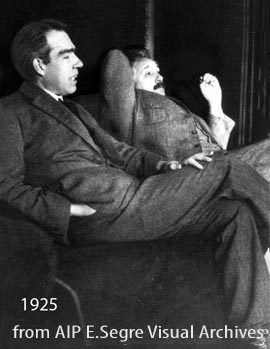
Bohr and Einstein. They must have talked about how the hydrogen atom would look to a moving observer. In order to answer this question, they needed the machine producing hydrogen atoms moving with relativistic speeds.
Click here for a detailed story.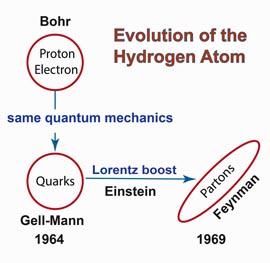
- However, when Bohr and Einstein talked, the hydrogen atom
moving with a relativistic speed was unthinkable. This is still
impossible, but there are these days many protons moving with
a speed close to that of light. On the other hand, do
the same quantum mechanics apply to the proton. Click
here for the evolution of the
hydrogen atom.
- Heisenberg in his article says
he could handle the mathematics of Lorentz transformations, but he
could not understand the physics of simultaneity. With this kind
of background, nobody could talk to Einstein. As for the
simultaneity, look at this page.
- I am not the first one to see this gap between Bohr and Einstein.
Indeed, Dirac, Wigner, and Feynman made major contributions toward
understanding this problem. I have been assembling their works
since 1970, after hearing
Feynman's talk given at the 1970 APS meeting in Washington, DC
in U.S.A. The result of my efforts is presented
in my Einstein page.
Remember this. If you are interested in building a canal, the only way is to connect the existing lakes. Dirac, Wigner, and Feyman served as the needed lakes for me. You may be interested those lakes.
Hidden behind Bohr and Einstein:
Time Separation

|
| They could have talked the Lorentz-boosted Bohr radius, but they did not. The time separation was a hidden variable to them. |
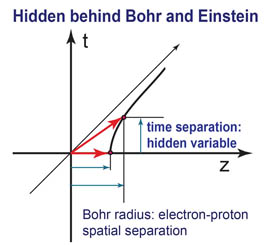
|
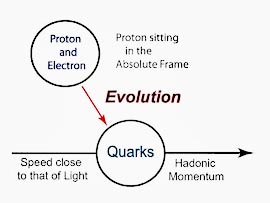
|
-
Niels Bohr (1885-1962) was born six years after Einstein. Whenever Bohr
mentions the word "space" in his philosophical writings, he adds "time."
This is how much Bohr respected Einstein. Einstein also had a
great respect for Bohr. At the same time, Einstein had his objections to
the Copenhagen interpretation of quantum mechanics. This aspect is
well known and is still actively debated by the present generation of
physicists.
- Niels Bohr is also well known for his Bohr radius. To him, the proton
was sitting at the center of the universe, even though he knew the existence
of the time variable associated with the space. Einstein perhaps thought
about the hydrogen atom in a moving frame, but he never said anything
about it. His Lorentz transformations are strictly for point particles.
Before saying there was something wrong with them, let us look at Thomas Jefferson. He said "All men are created equal." But he forgot to mention "women" there, and he was not able to practice his concept of equality with some of the the people who served him at his Virginia mansion called Monticello. Jefferson's freedom remained as a hidden variable to at least one half the world population for many years. It took many years of evolutionary processes to see the full extent of this variable. It is quite possible that this variable is still not completely discovered.
Let us go back to Bohr and Einstein. Physics is an experimental science. It is still unthinkable for the hydrogen atom to move with a relativistic speed, but the proton can be accelerated to a speed very close to that of light. The question then is whether the proton has it own quantum mechanics like the hydrogen atom. Yes, the quark model formulated in 1964 could tell the story. We can therefore illustrate the evolution of the hydrogen atom has gone through with this figure.
Needless to say, this evolution was made possible thanks to the advances in the accelerator physics. At the proton proton speed of 0.9999999999c. At magnitude of time separation is essentially the same as that of the spacial separation.
In order to study this hidden variable, I spent many years with Marilyn Noz. We published many papers, but we also had many problems with the referees, because the time-separation variable is thoroughly hidden to them.
- The first person who recognized the existence of this variable was
Richard Feynman. Based on his talk given at the 1970 APS spring meeting,
he published his paper with his students in
Phys. Rev. D 3 , 2706 (1971)]. In this paper, Feynman
et al. state the existence of the time-separation variable.
They said they could not do anything about this variable because they do
not anything about it. I like very much their honest statement.
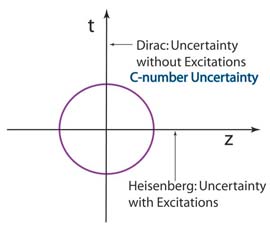
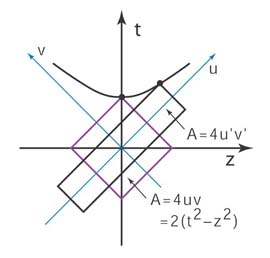
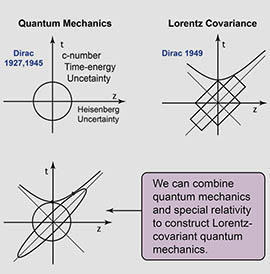
- As for the quantum mechanics of the time variable, Paul A. M. Dirac
worried about the time-energy uncertainty relation in his paper
- P. A. M. Dirac, Proc. Roy. Soc. (London) A114, 243 (1927).
He noted in this paper that the time-energy uncertainty relation is a c-number relation, and that this lack of time-like excitations makes it difficult to combine quantum mechanics with special relativity. In his 1945 paper:
- P. A. M. Dirac, Proc. Roy. Soc. (London) A183 , 284 (1945).
Dirac uses the four-dimensional harmonic oscillator to understand the Lorentz-covariant world. The fourth variable is the time variable. I assume he had in mind the time-separation variable. If we combine Dirac's 1927 paper with his 1954 paper, we end up with this figure with a circle.
In 1949, Einstein became 70 years old, and the Reviews of Modern physics published a special issue. This issue contains Dirac's paper:
- P. A. M. Dirac, Rev. Mod. Phys. 21 , 392 (1949).
It is then not difficult to combine the circle and the rectangle to construct the ellipse. Does this sound like a science fiction to you? We observe this effect whenever we turn on a particle accelerator. This is a picture of the proton released from the accelerator. Click here for a detailed story.
Paul A. M. Dirac was of course a great physicist. I seem to work strictly within his framework. I could do my own research because he left some soft spots in his papers.
- Dirac's papers are poems, but have you seen figures there. I seem to
enjoy translating his poems into cartoons.
- Dirac wrote many history making papers. However, Dirac seldom takes
advantage of his own papers published earlier. It is therefore profitable
to link up the papers Dirac published at different times.
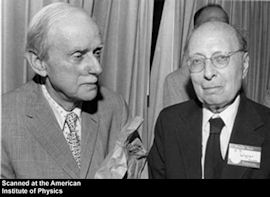
- Dirac had a "famous-brother-in-law" named Eugene Wigner who wrote
a paper on representations of the Poincare group in 1939. In his 1949
paper, Dirac said the task of constructing relativistic quantum mechanics
is the same as that of constructing a suitable representation of the
Poincare group.
When I talked with Dirac in 1978, he was still uncomfortable about the lack of time-like excitations in the Lorentz-covariant world. He used to call this space-time asymmetry. He could have learned about Wigner's O(3)-like little group to clarify the question of space-time asymmetry.
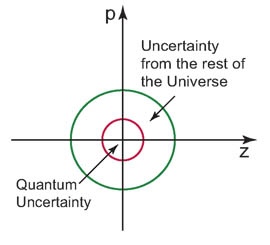
- Time Separation as a Hidden Variable: In spite of all I said above, the
time separation remains as a hidden variable to the absolute majority of
physicists even these days, especially to the orthodox Copenhageners. How do you
define the word "hidden" in physics? This concept came from the uncertainty
principle which does not allow a point in the phase space of position and
momentum.
The best way to approach this problem is to use the Wigner phase space, where position and momentum is confined in an area not smaller than Planck's constant. The area of uncertainty can increase if we fail to measure other variables. In that case, the region of uncertainty expands. In order to clarify this, we can use Feynman's rest of the universe.
- What is Feynman's rest of the universe? In
his book on statistical
mechanics (1972), Feynman says
When we solve a quantum-mechanical problem, what we really do is divide the universe into two parts - the system in which we are interested and the rest of the universe. We then usually act as if the system in which we are interested comprised the entire universe. To motivate the use of density matrices, let us see what happens when we include the part of the universe outside the system.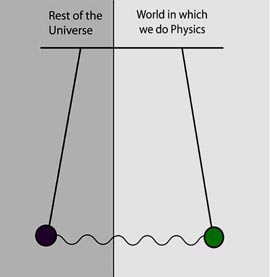
The best way to understand what Feynman says here is to use two coupled oscillators. One representing the system in which we are interested, and the other representing the rest of the universe.
- Click here for a webpage.
- Click here for an article published in the American Journal of Physics(1999).
The mathematics of the coupled oscillator system is exactly the same as the covariant harmonic oscillator which leads to Dirac's form of relativistic quantum mechanics, where one of the variable is the time-separation variable. It is not necessaary to write down lengthy formulas. The best way is to use a cartoon. It is even better if the cartoon is the one you have seen before. The net result is
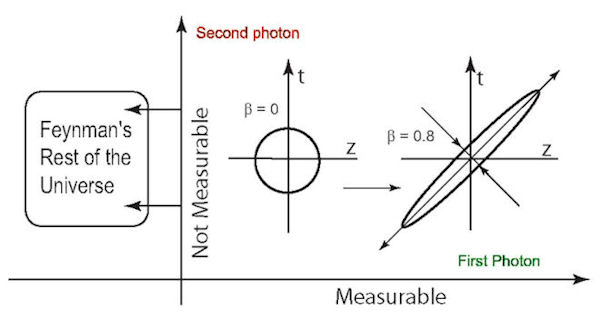
The space-time portion of this paper is from the paper I published with Wigner in 1990. The title of the paper is Entropy and Lorentz Transformations. If we do not measure the time-separation variable assuming it is hidden in Feynman's rest of the Universe, the net result is an increase in entropy and an expansion of the uncertainty region in the Wigner phase space. Click here for the phase space expansion.
This figure can be used for the two-photon coherent system or two-mode squeezed state. The labels "first photon" and "second photon" were added in my paper with Noz entitled "Time separation as a hidden variable in the Copenhagen school of quantum mechanics," in Advances in Quantum Theory, American Institute of Physics Conference Series No.1327, pp 138-147 (2001). ArXiv. As far as I can see, this story can be traced to Dirac's 1963 paper.
- P. A. M. Dirac was quite fond of harmonic oscillators and the
Lorentz group. He attempted to construct a representation of using two
oscillators, and ended up with the deSitter group applicable to five dimensional
space with three space and two time coordinates. Here is his paper.
- P. A. M. Dirac, J. Math. Phys. 4 , 901 (1963).
The result is that two-oscillator representation later became the language for two-mode squeezed state. I spent many years on this subject. Many people are saying I am crazy about the squeezed state. If so, it is because I am crazy about Dirac's papers. The original circle-ellipse figure for the covariant harmonic oscillator is again applicable to the two-photon states. In this case, both photons are observable, but we can choose not to observe the second photon. In this way, we can study the hidden time-separation variable using observable photons.
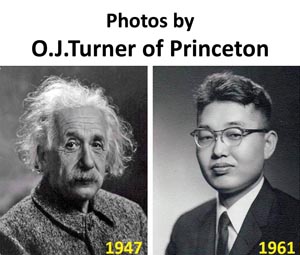
|
| How did he talk to Einstein? |
The photos of Bohr and Einstein and of Dirac and Wigner are from the E. Segre Visual Archives of the American Physical Society.
- Click here for his
home page.
- His Einstein page.
- His Princeton page.
- His stories.